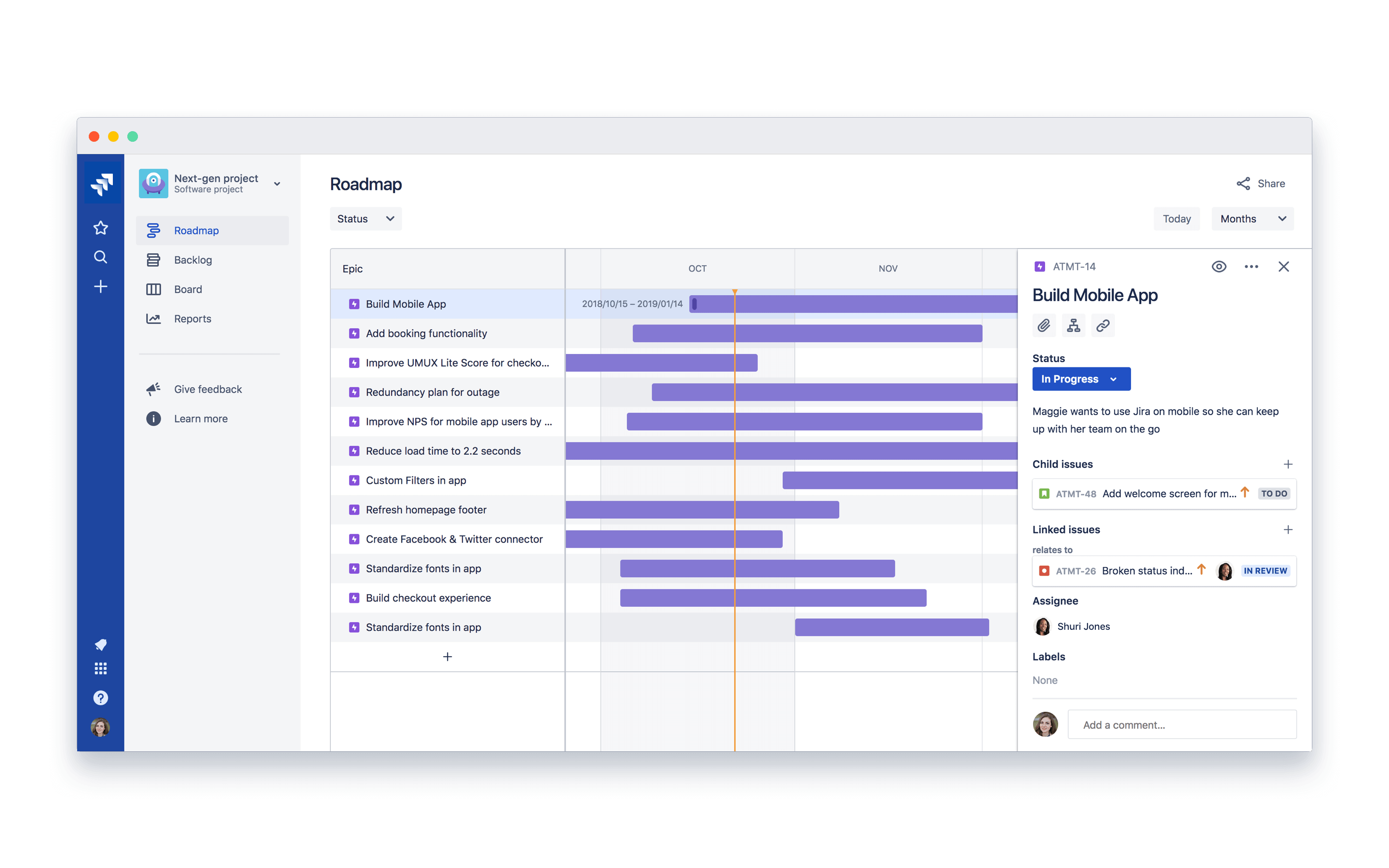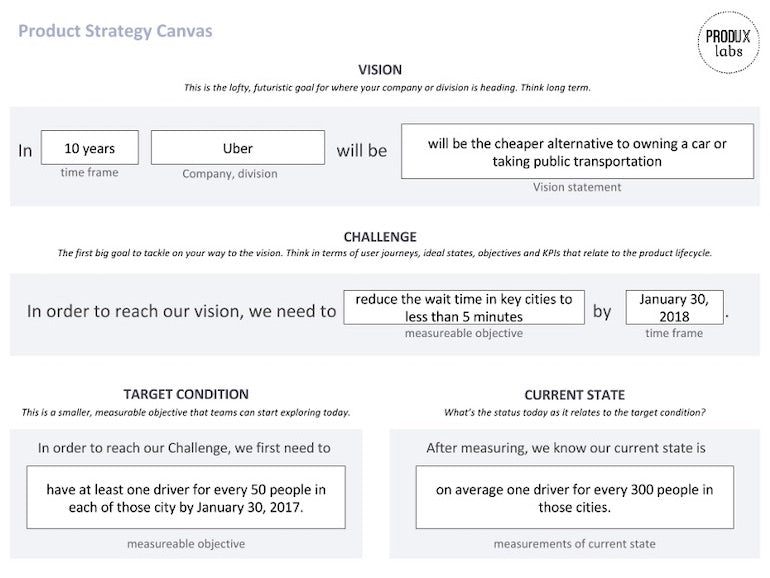PLAY Introduction
A product roadmap guides the direction of a product over time. It’s both a high-level summary and a strategic document that communicates what teams are building and why, with a clear strategic plan for execution. As the digital economy shifts and grows, the business and competitive landscape can change quickly product development teams need product roadmaps to:
- Align key stakeholders with competing needs
- Make objective prioritization decisions
- Develop a product against an overarching business strategy.
This play will help you deliver a product roadmap that works!
PEOPLE
2-10 depending on the size of the team. If it becomes larger than 10 people consider breaking out into smaller groups.
TIME
30-60 Minutes. No one wants to be in a meeting longer than needed. Try to keep it short and sweet.
NINJA LEVEL
Novice to Master. Anyone can develop great ideas!
PREP WORK
PEOPLE
This is key to successful meetings. Make sure all key stakeholders are on the invite, the decision makers and those funding the product. You need their buy-in from the start!
PLACE
Virtually or in-person it is critical that everyone has face-time with each other. So make sure that if attending virtually that everyone can connect in video chat. You will also need to share ideas, so a whiteboard is important and a space that fosters creativity and innovation.
THE PLAY
All of our plays are five steps or less! However, you may need to run multiple plays to get the most out of this one. Don’t worry – you can do it! Learn the play, rehearse it regularly, apply it in the field and debrief on the outcomes. If it worked well, use it again; if it didn’t, find out why. Are there new factors in the system you need to consider, or do you just need to keep practicing? If you need help or have questions on this play, contact us!
01
SET THE STAGE
Who are the players?
Every winning team knows which players to have on the field and what talent you need on the ready. To successfully deploy this play you will need the following roster:
![]() Meeting Facilitator: Likely this is you! But you don’t have to do it alone, ask a friend (think of it like a football team that has a coach for different parts of the team). Skills needed:
Meeting Facilitator: Likely this is you! But you don’t have to do it alone, ask a friend (think of it like a football team that has a coach for different parts of the team). Skills needed:
- Keep the team focused on the goal!
- Foster a positive and creative space for all
- Organized and prepared to run play
![]() Product Manager: A product manager is a professional role that is responsible for the development of products for an organization, known as the practice of product management. Product managers own the business strategy behind a product, specify its functional requirements, and generally manages the launch of features. Skills needed:
Product Manager: A product manager is a professional role that is responsible for the development of products for an organization, known as the practice of product management. Product managers own the business strategy behind a product, specify its functional requirements, and generally manages the launch of features. Skills needed:
- Ability to balance business and user needs
- Attention to detail
- Curiosity to explore new ideas
- Ability to deliver factual data in-time
- Empathy for customers
- Ability to build strong relationships with other teams
- Understanding of necessary data structures
- Informed about the technical implications of the platforms being used
- Ability to tailor communications to different stakeholders
![]() Product/System/Business Unit Owners: These are decision makers. They can make the call on what changes will happen or authorize a strategy. Skills needed:
Product/System/Business Unit Owners: These are decision makers. They can make the call on what changes will happen or authorize a strategy. Skills needed:
- Change agent. Supportive and enthusiastic about improvements.
- Supportive of the team and SMEs!
- Committed and engaged in the product.
![]() Subject Matter Experts (SMEs): A SME (pronounced S-Mee) is critical for this play. They will help drive the team to a shared understanding of what is needed to win. Skills needed:
Subject Matter Experts (SMEs): A SME (pronounced S-Mee) is critical for this play. They will help drive the team to a shared understanding of what is needed to win. Skills needed:
- Specific domain knowledge, narrow and deep rather than broad and shallow.
- Communication and team collaboration. They must be able to share with others the knowledge they have on a particular subject.
Get the field ready!
![]() Schedule the meeting in advance. Don’t wait until the last minute to schedule the meeting. You want people to be excited about it but not so last minute that they have no time to prepare.
Schedule the meeting in advance. Don’t wait until the last minute to schedule the meeting. You want people to be excited about it but not so last minute that they have no time to prepare.
![]() Include an agenda. Set expectations – this will help keep your meeting on track. Include schedule and any prep work needed. Also let them know if it is okay to invite others or not. Remember that if you have to many people in the meeting, it will be difficult to facilitate brainstorming sessions without breaking out into smaller groups.
Include an agenda. Set expectations – this will help keep your meeting on track. Include schedule and any prep work needed. Also let them know if it is okay to invite others or not. Remember that if you have to many people in the meeting, it will be difficult to facilitate brainstorming sessions without breaking out into smaller groups.
![]() Prep the room. Arrive early and get ready. If it is in a physical room, get whiteboards ready, enough chairs for everyone, water and snacks are always a hit! If virtually, a central location for notes, brainstorms and follow-up items. Test connectivity in the meeting room and make sure there is enough seats for all participants.
Prep the room. Arrive early and get ready. If it is in a physical room, get whiteboards ready, enough chairs for everyone, water and snacks are always a hit! If virtually, a central location for notes, brainstorms and follow-up items. Test connectivity in the meeting room and make sure there is enough seats for all participants.
02
CORE ACTIVITIES
BUILD THE ROADMAP
You might do these activities on your own or with the team. If working with the team, work in a collaborative space and document outcomes!
Steps for building a product roadmap:
- Define the strategy. A product strategy is how you make the case for your product. Strategy is more of the ‘why’ we do something than the ‘what’. Most companies fall into the trap of thinking about Product Strategy as a plan to build certain features and capabilities. This isn’t a strategy, this is a plan. The problem is that when we treat a product strategy like a plan, it will almost always fail.
Setting a product strategy is not easy and nearly impossible to provide a one-size-fits-all guide. However, we can help get you and your team started on creating an effective product strategy with these few tips:- Identify your target audience
- Understand the problem
- Define your product vision
- Define the current state and future/target state
- Define success metrics
- Map to a Project Strategy Canvas (template here). Below is an example for Uber created by Melissa Perri:

- Review and manage ideas. If you haven’t already, run the Ideation play to generate ideas. You should have a good list of things you want to do that will deliver value for the product and align to a vision statement.
- Organize into releases/timelines. Time to run the Prioritizing Work play if you haven’t already. You should have a great idea of which ideas will deliver the highest value at the lowest cost. Group those into themes and a timeline of delivery.
TAILOR THE ROADMAP
Before spending time creating the perfect roadmap, think about the various audiences and uses. You may need a summary roadmap for Executives, a feature one for Sales and a detailed sprint level roadmap for Development. You can help persuade stakeholders by customizing and presenting a roadmap tailored to their particular interests.
Here’s are some common internal stakeholders and the information they typically want in a product roadmap:
- Company executives and upper management: All of the elements outlined in your product strategy, plus any data regarding market size.
- Marketing: Product features, how your product will compare to similar products on the market, and your product’s potential for generating sales.
- Sales: Release dates and specifics about the benefits and advantages the product provides to customers. Remember: instead of promising hard release dates, display general timelines.
- Engineers and developers: Requirements, deadlines, sprints, and specific tasks.
You do not necessarily have to create multiple versions of your roadmap for each group of stakeholders. Instead, you can use a flexible online tool to highlight the information that is most relevant to a particular party.
My favorite tool for Roadmaps is Atlassian’s Roadmap tool:

This tool allows custom views for Executives and Development teams. It can be organized by sprints, themes or numerous other categories. It is a real time view of your product progress and future state.
SHARE THE ROADMAP
Sharing your roadmap has several benefits. Aside from encouraging team engagement and gaining upper management support, your roadmap communicates all the progress you’ve made and sets expectations for next stages. Whether you choose to share your roadmap using spreadsheets, PowerPoint, or with a cloud-based software program, sharing your roadmap is an important step to ensure accountability among your team, and keep everyone up to date.
How to Present Your Roadmap in 4 Steps
- Know your audience. To executives, the roadmap validates your product’s usefulness to a market that aligns with the organization’s strategic direction, and also proves that it enhances the company’s position. To your development team, your roadmap demonstrates progress and fosters inspiration. And to other internal departments—sales and marketing—your product roadmap sets expectations about product benefits, its comparisons to other similar products, and the potential for conversions.
- Focus on the narrative. An effective product roadmap will do more than ‘tell:’ it will also present a simple, realistic visual representation of your vision and how it is tied to company’s goals. Additionally, your roadmap should be easy to understand and persuasive.
- Stay high level. Don’t get to caught up in the details, stick to the main purpose and strategy. Win over your audience and get them onboard with your vision. Often meeting participants will want to dive into the details and start solutioning. Remind them this is to get a shared understanding of the overall roadmap and there will be future meetings for solutions and detailed strategy. Be sure to keep your word and schedule follow-up meetings!
- Add some metrics to the message. Be sure to answer, “How will we know if this works?”. It should be easy for your audience to understand what the goal line is and when you have crossed it. Good goals are SMART:
- Specific
- Measurable
- Achievable
- Relevant
- Time-sensitive
Want more information on creating a product strategy? See this article by Nick Babich.
03
 TEAM HUDDLE
TEAM HUDDLE
Time to run the Team Huddle play. Ask the team the following questions and then take a vote. Keep follow-up questions to a minimum and capture any issues raised as an offline follow-up (and be sure to follow-up).
Understand the play?
![]() The play was understood and I asked any questions in time!
The play was understood and I asked any questions in time!
![]() I’m not sure I understand and I have some questions …
I’m not sure I understand and I have some questions …
![]() I did not understand the play or my part in it.
I did not understand the play or my part in it.
Did you get in the game?
![]() Yes, I made my moves and was in the right place at the right time!
Yes, I made my moves and was in the right place at the right time!
![]() I’m not sure I understand what I was supposed to do …
I’m not sure I understand what I was supposed to do …
![]() I kept the bench warm and watched from the sidelines.
I kept the bench warm and watched from the sidelines.
Ready for what’s next?
![]() Yes, I know the game plan and ready to win!
Yes, I know the game plan and ready to win!
![]() I’m not sure what’s next or if I am involved …
I’m not sure what’s next or if I am involved …
![]() No clue what’s next and would rather sit it out.
No clue what’s next and would rather sit it out.
04
NEXT STEPS
Phew! The hard part is done! You might be tempted to go further and discuss the how the product roadmap creates a nice product backlog – but don’t! Instead congratulate the team on a very successful and productive meeting!

![]() Schedule the next meeting where the team will take the next steps in prioritizing the work. Set a regularly reoccurring meeting cadence so that the team stays engaged and is front of mind.
Schedule the next meeting where the team will take the next steps in prioritizing the work. Set a regularly reoccurring meeting cadence so that the team stays engaged and is front of mind.
![]() Publish your notes in a central repository that the team has access to immediately. Even better if it is someplace that the team can add comments or collaborate on. Keep the creative chat going!
Publish your notes in a central repository that the team has access to immediately. Even better if it is someplace that the team can add comments or collaborate on. Keep the creative chat going!
05
IT’S A WRAP
You did it! Now just a few follow-up items:
- Reflect on the play. Ask yourself how it went? What could have gone better, what could have gone worse? In sports this is watching the game again to see any plays that could have been better. Update your playbook. Build feedback loops that help you see what’s working; what’s not; and how to continue to develop the playbook by learning, adapting and iterating constantly as situations change and new challenges arise.
- Contribute to the community of Playbook.Ninja. Sign-up for an account and receive updates on when new plays are added and help others by commenting on the plays with what worked or your experience.
Thank you for being a Playbook.Ninja
![]()






 TEAM HUDDLE
TEAM HUDDLE